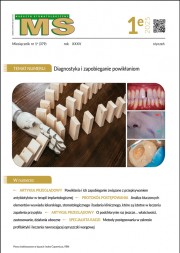Dostęp do tego artykułu jest płatny.
Zapraszamy do zakupu!
Po dokonaniu zakupu artykuł w postaci pliku PDF prześlemy bezpośrednio pod twój adres e-mail.
Elżbieta Jaszczak, Jacek Matys
Streszczenie
Strach przed bólem jest jednym z najistotniejszych bodźców powodujących niepokój u pacjentów. Przedstawione w artykule badanie miało na celu porównanie odczucia bólu podczas podawania komputerowo kontrolowanego znieczulenia za pomocą systemu Calaject® (Ronvig, Dania) i tradycyjnej karpuli. Badaniem objęto 60 pacjentów, których podzielono na grupy: kontrolną (karpula) i eksperymentalną (Calaject®). W każdej z grup podano znieczulenie miejscowe nasiękowe od strony policzka i podniebienia oraz znieczulenie przewodowe do otworu żuchwowego. Odczucie bólu oceniano za pomocą 11-stopniowej skali NRS. Poziom bólu w obydwu grupach był najmniejszy podczas podania znieczulenia nasiękowego od strony policzkowej (grupa kontrolna – NRS = 2,84, grupa eksperymentalna Calaject® – NRS = 1,68). Podanie znieczulenia nasiękowego od strony podniebiennej za pomocą urządzenia Calaject® (NRS = 2,08) skutkowało niższym odczuciem bólu niż podczas tradycyjnego znieczulenia (NRS = 3,80). Poziom bólu podczas deponowania znieczulenia przewodowego w obydwu grupach (eksperymentalna – NRS = 3,68, kontrolna – NRS = 3,52) był podobny. Wykonanie znieczulenia nasiękowego wymaga jednego wkłucia igły na niewielką głębokość. Natomiast podając znieczulenie przewodowe, igłę wprowadza się głębiej, co skutkuje większym dyskomfortem i stąd prawdopodobnie brak różnicy statystycznej między dwiema grupami.
Abstract
Fear of pain is one of the most important motives causing anxiety among patients. Our study aimed to compare the pain sensation when administering computer-controlled anesthesia with the Calaject® system (Ronvig, Denmark) and the traditional carpoule. The study included 60 patients who were divided into control (carpoule) and experimental groups (Calaject®). In each group, infiltration of anesthesia from the cheek, palate and mandibular nerve was administered. The pain was gauged using the 11-point NRS scale. The level of pain in both groups was the lowest when applying buccal analgesia (control group (NRS = 2,84) and experimental – Calaject® (NRS = 1,68). Administration of anesthesia to the palate with the Calaject® appliance (NRS = 2,08) results in a lower pain sensation than in conventional anesthesia (NRS = 3,80). The level of pain during mandibular anesthesia in both groups (experimental group (NRS = 3,68), control group (NRS = 3,52) was similar. One needle insertion to a small depth is required to the administration of infiltration anesthesia. Whereas, for injection of mandibular anesthesia, the needle is inserted to a greater depth, which results in greater discomfort, therefore probably no statistical difference between the two groups.
Hasła indeksowe: ból, NRS-11, znieczulenie
Key words: pain, NRS-11, anesthesia
PIŚMIENNICTWO
1. Heaton L.J.: Self-reported dental anxiety is associated with both state anxiety and dental procedure-related pain. J. Evid. Based Dent. Pract. [Internet], 2017, 17, 1, 45-47.
2. Hakim H., Razak I.A.: Dental fear among medical and dental undergraduates. ScientificWorldJournal [Internet], 2014, 747508.
3. Ghaderi F., Banakar S., Rostami S.: Effect of pre-cooling injection site on pain perception in pediatric dentistry: A randomized clinical trial. Dent. Res. J. (Isfahan), 2013, 10, 790-794.
4. Hochman M.N., Friedman M.J.: In vitro study of needle deflection: a linear insertion technique versus a bidirectional rotation insertion technique. Quintessence Int., 2000, 31, 1, 33‐39.
5. Allen K.D. i wsp.: Comparison of a computerized anesthesia device with a traditional syringe in preschool children. Pediatr. Dent., 2002, 24, 315-320.
6. Salgotra V., Agrawal Rm Mandal S., Kohli S.: New gadgets in local anesthesia: A review. IOSR-JDMS, 2014, 13, 62-66.
7. Rosenberg E.S.: A computer‐controlled anesthetic delivery system in a periodontal practice: patient satisfaction and acceptance. J. Esthet. Restor. Dent., 2002, 14, 1, 39‐46.
8. Krochak M., Friedman N.: Using a precision metered injection system to minimize dental injection anxiety. Compendium, 1998, 19, 137-148.
9. Manani G. i wsp.: Analysis of an anxiolytic technique applied in 1179 patients undergoing oral surgery. Minerva Stomatol. [Internet], 2005, 54, 10, 551-568.
10. Lipp M. i wsp.: Exogenous and endogenous plasma levels of epinephrine during dental treatment under local anesthesia. Reg. Anesth. [Internet], 18, 1, 6-12.
11. Liau F.L. i wsp.: Cardiovascular influence of dental anxiety during local anesthesia for tooth extraction. Oral Surg. Oral Med. Oral Pathol. Oral Radiol. Endod. [Internet], 2008, 105, 1, 16-26.















